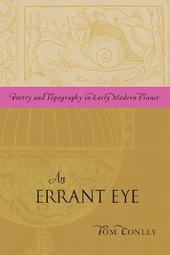
|
An Errant Eye: Poetry and Topography in Early Modern France
Paperback / softback
Main Details
| Title |
An Errant Eye: Poetry and Topography in Early Modern France
|
| Authors and Contributors |
By (author) Tom Conley
|
| Physical Properties |
| Format:Paperback / softback | | Pages:264 | | Dimensions(mm): Height 229,Width 152 |
|
| Category/Genre | British and Irish History |
|---|
| ISBN/Barcode |
9780816669653
|
| Classifications | Dewey:912.014 841.30932 |
|---|
| Audience | | General | | Professional & Vocational | |
|---|
|
Publishing Details |
| Publisher |
University of Minnesota Press
|
| Imprint |
University of Minnesota Press
|
| Publication Date |
10 January 2011 |
| Publication Country |
United States
|
Description
An Errant Eye studies how topography, the art of describing local space and place, developed literary and visual form in early modern France. Arguing for a "new poetics of space" ranging throughout French Renaissance poetry, prose, and cartography, Tom Conley performs dazzling readings of maps, woodcuts, and poems to plot a topographical shift in the late Renaissance in which space, subjectivity, and politics fall into crisis. He charts the paradox of a period whose demarcation of national space through cartography is rendered unstable by an ambient world of printed writing.
Author Biography
Tom Conley is Lowell Professor of Romance Languages and Literatures and chair of visual and environmental studies at Harvard University. Among his books are Cartographic Cinema (2007) and Film Hieroglyphs (2006), both published by Minnesota.
Reviews"Practicing a highly skillful and imaginative form of criticism, Tom Conley sets for himself the task of unveiling the birth of modern subjectivity in early modern representational artifacts such as maps and literary texts. His readings of textual and visual media are thoroughly gratifying and even exhilarating in their illuminating inventiveness, uncovering meanings unattainable by safer, traditional hermeneutic means." -Jean-Claude Carron, UCLA "In An Errant Eye, Tom Conley slows down our encounter with the Renaissance to a snail's pace. At this tactical speed he leads us across a series of local topographies-topographies of print created by Rabelais, Montaigne, the cosmographer Peter Apian, and other writers and poets of the sixteenth century who felt their way through a radically unstable world. Conley has once again given us a brilliant exploration of the spatial imagination of the French Renaissance, one whose impact will be felt across the disciplines." -Michael Gaudio, University of Minnesota
|